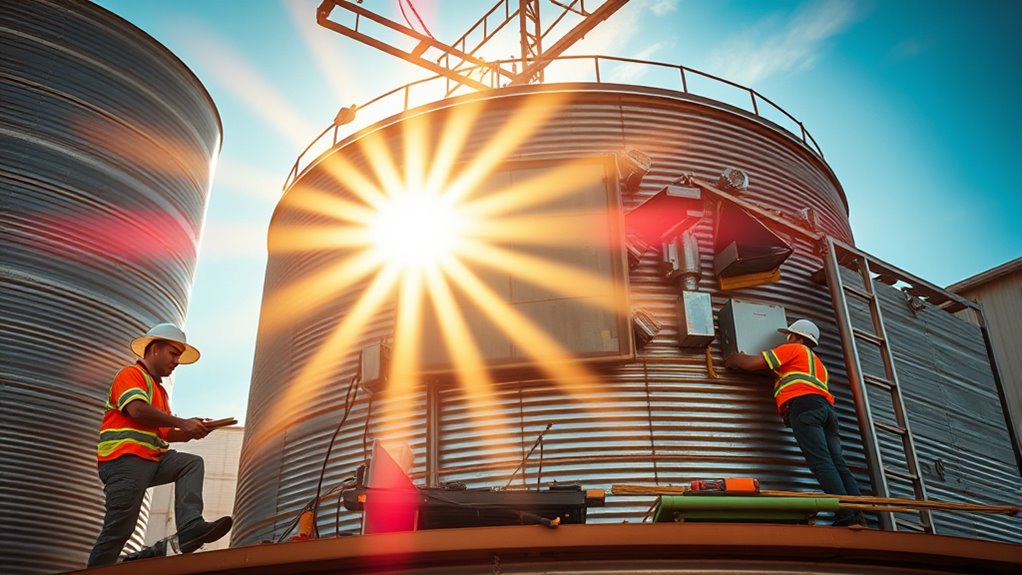During hot months, protecting yourself around grain bins is vital. Recognize early signs of heat illness, stay hydrated with water and electrolytes, and avoid sugary drinks. Make sure proper ventilation inside bins to prevent heat buildup, and always follow safety procedures before entry, including checking for hazardous gases. Schedule work during cooler times, take regular breaks, and rotate tasks to reduce heat stress. Keep safety equipment ready—if you continue, you’ll find how to keep safety top of mind.
Key Takeaways
- Recognize early heat-related illness symptoms and respond immediately with hydration, shade, and medical attention if needed.
- Maintain proper hydration through frequent water intake, using water stations and monitoring urine color.
- Ensure effective ventilation and airflow in grain bins, checking equipment regularly and monitoring internal temperatures.
- Use proper safety procedures for confined space entry, including gas testing, safety gear, and trained standby personnel.
- Schedule work during cooler times, enforce regular breaks, and rotate tasks to prevent heat stress and fatigue.
Recognizing the Signs of Heat-Related Illnesses

Heat-related illnesses can develop quickly when working in a grain bin, especially during hot weather or if you’re dehydrated. Early signs include dizziness, headache, and excessive sweating. Pay attention to your body’s signals—if you start feeling weak or nauseous, take action immediately. Climate control within the grain bin, like proper ventilation, helps regulate temperature and reduce risk. Additionally, heat acclimatization is key; gradually increasing your exposure to hot conditions allows your body to adapt better. Recognizing these signs early can prevent severe health issues like heat exhaustion or heat stroke. Proper workplace safety protocols are essential for preventing heat-related health issues. Prevention begins with awareness and prompt response. Understanding emotional regulation can also help manage stress and physical symptoms related to heat stress. Incorporating energetic alignment techniques can also support mental resilience during high-stress, hot working conditions. Monitoring hydration levels and taking regular breaks can further reduce risk and prevent heat-related injuries. Staying informed about credit card safety and maintaining secure payment practices can also be crucial during busy work periods, especially when stress levels are high. Always monitor yourself and coworkers, especially during peak heat, and don’t ignore symptoms that indicate your body is struggling with the heat.
Proper Hydration and Nutrition Strategies

Staying properly hydrated is key to preventing heat stress during work in grain bins. Choose nutritious snacks like fresh fruit or nuts to maintain your energy levels. Recognize the signs of heat stress early so you can take action before it becomes serious. Being aware of proper hydration and its role in overall safety can make a significant difference. Maintaining nutrient intake is essential for sustaining energy and supporting your body’s ability to manage heat stress effectively.
Hydration Importance During Heat
When working in hot conditions, maintaining proper hydration is essential to prevent heat-related illnesses and stay safe inside grain bins. Hydration strategies focus on consistent water intake throughout your shift, not just when you feel thirsty. Drink small amounts frequently to keep your body hydrated and replace fluids lost through sweating. Carry a reusable water bottle or ensure easy access to water stations. Avoid sugary drinks or caffeine, which can dehydrate you further. Monitoring your urine color is an effective way to check hydration—aim for light yellow. Staying properly hydrated helps regulate body temperature, maintain energy levels, and prevent heat exhaustion or heat stroke. Proper hydration also supports overall health by reducing the risk of dehydration-related complications related to heat stress. Incorporating hydration monitoring techniques can further enhance your safety during high-heat months. Being aware of sweat loss rates helps you adjust your fluid intake appropriately. Proper hydration strategies are crucial for safeguarding your health during high-heat months. Prioritize water intake as a key safety measure during high-heat months to protect yourself while working in grain bins. Using a word counter tool can help you keep your script timing accurate if you’re recording safety messages or instructions.
Nutritious Snack Options
Proper hydration goes hand in hand with good nutrition, especially when working in hot conditions like inside grain bins. To support your energy and safety, choose nutritious snacks that provide sustained energy without causing dehydration. Fresh fruits like watermelon, oranges, and berries are excellent options—they’re hydrating and rich in vitamins. Nuts and seeds offer healthy fats and protein, helping you stay alert. Incorporate hydration strategies such as electrolyte drinks or water-rich foods to further boost your hydration levels. Including electrolyte balance in your hydration plan can help replace essential minerals lost through sweat. Maintaining adequate fluid intake throughout the day is essential for preventing dehydration and heat-related illnesses. Avoid sugary or processed snacks that can lead to energy crashes. Keep a supply of these nutritious options nearby, and ensure safety signage reminds everyone about proper nutrition and hydration practices around grain storage areas. Staying fueled with the right snacks not only boosts your performance but also helps maintain focus and safety in high-heat environments. Proper hydration is crucial for preventing heat-related illnesses and maintaining optimal physical performance. In addition, AI-powered safety monitoring tools can help identify hazardous conditions in real-time, further enhancing workplace safety.
Recognizing Heat Stress Symptoms
Recognizing heat stress symptoms early can prevent serious health issues and keep you safe on the job. Heat exhaustion is a common sign, characterized by heavy sweating, weakness, dizziness, and nausea. If you notice these signs, it’s critical to act quickly. Maintaining electrolyte balance is key to preventing heat-related illnesses; dehydration and loss of salts can worsen symptoms. Drink plenty of water and consider electrolyte-replenishing drinks, especially during prolonged heat exposure. Pay attention to your body’s signals—fatigue, muscle cramps, or a feeling of being overheated may indicate you’re at risk. Being aware of heat stress symptoms can help you respond promptly and effectively. Proper hydration strategies, such as scheduling regular water intake and using electrolyte drinks, are essential to maintaining your health. Implementing preventative measures like taking frequent breaks in shaded areas can further reduce your risk of heat-related illnesses. Additionally, understanding the importance of heat stress management can significantly reduce your risk of heatstroke. Staying informed about regional heat-related statistics can help you better prepare for high-heat conditions. By staying alert and properly hydrating, you can catch heat stress symptoms early and avoid more severe conditions like heatstroke. Your awareness and quick response are crucial for safety in high-heat environments.
Ensuring Adequate Ventilation and Airflow

Effective ventilation and airflow are indispensable for maintaining a safe grain bin environment. Regular ventilation system maintenance guarantees your equipment functions properly, preventing hot spots and moisture buildup. Proper airflow optimization keeps the grain dry and cool, reducing the risk of spoilage and heat-related hazards. Check fans, vents, and ducts frequently for blockages or damage, and ensure they operate efficiently. Use sensors or temperature monitoring devices to track airflow and temperature changes inside the bin. Adjust ventilation settings as needed, especially during hot weather, to promote consistent air exchange. Good airflow reduces the likelihood of heat accumulation, making the bin safer for workers. Incorporating tuning techniques and regular maintenance routines can further enhance ventilation performance. Prioritizing ventilation system upkeep and airflow management is crucial for a secure, high‑heat season.
Safe Entry Procedures and Confined Space Precautions

Entering a grain bin safely requires following strict procedures because confined spaces pose significant hazards. Before entry, ensure all safety equipment is in place, including harnesses, proper lighting, and gas detectors to monitor oxygen levels. Always test the atmosphere for hazardous gases and ensure ventilation is adequate. Never enter alone; have a trained standby person outside the bin ready to assist if needed. Use confined space entry permits to confirm all safety measures are followed. Keep communication devices handy and maintain constant contact with the outside team. Remember, grain storage environments are unpredictable, so respecting confined space precautions is essential for your safety. Proper training and adherence to these procedures help prevent accidents and ensure safe grain bin entries.
Fire Prevention and Emergency Response Measures

To prevent fires and respond quickly if they occur, you need to implement proactive safety measures and be prepared for emergencies. During grain handling, ensure fire extinguishers and safety equipment are accessible and regularly maintained. Train your team on fire prevention tactics, like avoiding sparks and static buildup.
Implement safety measures, maintain equipment, and train staff to prevent and respond swiftly to fires during grain handling.
Consider these key steps:
- Install smoke detectors and fire suppression systems in grain bins and handling areas.
- Conduct routine inspections of grain handling equipment for potential fire hazards.
- Develop and rehearse emergency response plans, so everyone knows how to react swiftly.
Having the right safety equipment and clear procedures in place minimizes risks and helps you act fast if a fire breaks out, protecting both your workers and your crops.
Implementing Effective Work Schedules and Breaks

To keep workers safe, plan your schedule to include cooler work hours when temperatures are highest. Make sure to enforce regular rest breaks to prevent fatigue and accidents. Rotating tasks frequently helps maintain alertness and reduces the risk of strain or injury.
Schedule Cooler Work Hours
Have you considered how scheduling work during cooler parts of the day can substantially improve safety around grain bins? Utilizing cooler work schedules and adjusted work hours helps reduce heat stress and fatigue. Here are three ways to implement this effectively:
- Start early in the morning before temperatures peak.
- Shift heavier tasks to late afternoon or evening when it’s cooler.
- Limit outdoor activities during the hottest hours, typically midday.
Enforce Rest Breaks
Why are regular rest breaks essential when working around grain bins? When temperatures soar, your body needs time to cool down and stay hydrated. Enforcing scheduled rest breaks allows you to take advantage of hydration stations and cooling zones, reducing the risk of heat exhaustion or heat stroke. Breaks help prevent fatigue, which can impair judgment and increase accident risk. Make sure to set designated times for breaks and encourage workers to step into cooling zones, sip water, and rest away from direct heat. Consistent breaks also promote alertness and physical recovery, keeping everyone safer. By actively enforcing rest schedules, you reduce heat-related health issues and maintain a safer work environment during high-heat months.
Rotate Tasks Regularly
Rotating tasks regularly keeps workers engaged and prevents fatigue from prolonged activity in one position. By implementing task rotation, you reduce the risk of heat exhaustion and improve overall safety. Schedule workers to switch between different tasks, such as monitoring equipment, inspecting grain, and performing equipment maintenance. This approach ensures no one is overexposed to heat or repetitive motions. To paint a clear picture:
- You might have a worker inspect grain bins for signs of spoilage, then switch to cleaning or lubrication tasks.
- Rotate equipment maintenance duties to prevent burnout and ensure machinery stays in top shape.
- Regularly changing tasks helps identify potential hazards early and keeps workers alert during high-heat months. This strategy promotes safety and efficiency throughout your operation.
Frequently Asked Questions
What Are the Latest Technological Tools for Monitoring Grain Bin Temperatures?
You can now use advanced grain bin sensors to monitor temperatures in real-time, helping prevent spoilage and safety hazards. Thermal imaging cameras also provide a quick, non-invasive way to spot hot spots on the bin’s surface. These tools give you precise data, allowing you to act swiftly if temperatures rise unexpectedly. Staying updated with these technologies guarantees you maintain safer, more efficient grain storage, especially during high-heat months.
How Can Workers Identify Early Symptoms of Heat Exhaustion On-Site?
You should stay alert for early symptoms of heat exhaustion, like heavy sweating, weakness, dizziness, nausea, or headache. If you notice these signs, immediately stop working, move to a cooler area, and hydrate. Recognizing early symptoms helps prevent heat exhaustion from worsening. Regularly check yourself and coworkers, and don’t ignore any discomfort—prompt action keeps everyone safe in hot conditions on-site.
Are There Specific Clothing Materials Recommended for High-Heat Grain Bin Work?
Imagine working under a blazing sun, feeling the heat seep through your clothing. For high-heat grain bin work, you should wear moisture-wicking fabrics that draw sweat away, keeping you cooler. Flame-resistant clothing is essential for safety, protecting you from sparks or fires. These materials help you stay comfortable and safe, much like a shield against the intense summer heat, ensuring you can work efficiently without overheating.
How Often Should Ventilation Systems Be Inspected During Peak Summer Months?
You should perform ventilation maintenance regularly during peak summer months. Inspection frequency depends on usage and environmental conditions, but it’s recommended to verify systems at least once a month. Regular inspections help identify blockages, mechanical issues, or wear that could reduce airflow. Staying proactive with ventilation system inspections ensures proper airflow, keeps the environment safe, and prevents heat buildup that could pose risks during high-heat months.
What Legal Regulations Govern Grain Bin Safety During Hot Weather Conditions?
You might worry about complex rules, but legal compliance and safety regulations are designed to protect you during hot weather. These laws require regular safety checks, proper ventilation, and emergency protocols. By following them, you guarantee safe grain bin operations, reducing risks of heat stress or accidents. Don’t overlook these regulations—staying compliant keeps you and your team safe, especially when temperatures soar.
Conclusion
Staying safe in grain bins during hot months is vital. Keep an eye out for signs of heat illness, stay hydrated, and guarantee proper ventilation. Follow safe entry protocols and be prepared for emergencies—think of it as your modern-day Hippocratic oath for farm safety. Remember, taking breaks and scheduling work wisely can make all the difference. Don’t let safety become an afterthought; your well-being is worth more than any gold rush!










